
A synagogue, also called a shul or a temple, is a place of worship for Jews and Samaritans. It has a place for prayer where Jews attend religious services or special ceremonies such as weddings, bar and bat mitzvahs, choir performances, and children's plays. They also have rooms for study, social halls, administrative and charitable offices, classrooms for religious and Hebrew studies, and many places to sit and congregate. They often display commemorative, historic, or modern artwork alongside items of Jewish historical significance or history about the synagogue itself.
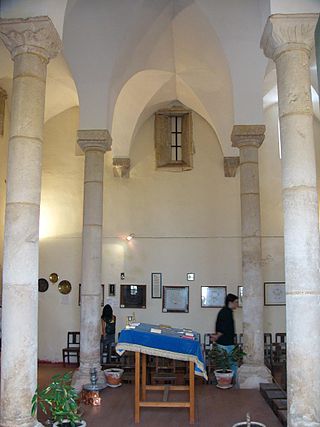
The Synagogue of Tomar is a former Jewish congregation and synagogue, located at 73 Rua Dr. Joaquim Jaquinto, in the historic center of the city of Tomar, in the Santarém District of Portugal. The medieval synagogue was completed in the Gothic style by c. 1460, and was active as a synagogue until 1496, when Jews were expelled from Portugal.

There are many synagogues in the Indian subcontinent, although many no longer function as such and today vary in their levels of preservation. These buildings dating from the mid-sixteenth through the mid-20th century once served the country's three distinct Jewish groups—the ancient Cochin Jews, and Bene Israel communities as well as the more recent Baghdadi Jews.

The Zamość Synagogue, also the Zamość Old Synagogue or the Great Synagogue of Zamość, is a former Jewish congregation and synagogue, located in Zamość, in Lublin Voivodeship, Poland. Completed in 1618 in the Renaissance style, the synagogue is a UNESCO-protected World Heritage Site of Poland. Erected during the times of the Polish–Lithuanian Commonwealth, it functioned as a place of worship for Polish Jews until World War II, when the Nazis turned the interior into a carpenters' workshop. The structure was spared from destruction and in 1992 was listed as a World Heritage Site as part of the Old City of Zamość.

The Old Synagogue was a former Orthodox Jewish congregation and fortress synagogue, located at 24 Szeroka Street, in the Kazimierz district of Kraków, in the Lesser Poland Voivodeship of Poland.

The Kupa Synagogue, also known as the Synagogue of the Poor, is a former Jewish congregation and synagogue, that is located at 8 Warszauera Street, in the historic Kazimierz district of Kraków, in the Lesser Poland Voivodeship of Poland. The 17th-century former synagogue is located in a neighborhood earmarked in 1495 by King John I Albert for the Jewish community, that was transferred from the budding Old Town.

The Golden Rose Synagogue, known also as the Nachmanowicz Synagogue, or the Turei Zahav Synagogue was an Orthodox Jewish synagogue, located in Lviv, in what is now the Lviv Oblast in western Ukraine. The Golden Rose Synagogue, established in 1582 in the Polish–Lithuanian Commonwealth, was the oldest synagogue in what is now Ukraine. From September 1603 until 1801, the Golden Rose served as the main communal synagogue while the Great City Synagogue expanded its facilities. Both the Golden Rose and Great City synagogues were destroyed by Nazis during World War II.

The Łańcut Synagogue is a former Jewish congregation and synagogue, located in Łańcut, in Podkarpackie Voivodeship, Poland. Completed in 1761, it served as a house of prayer until World War II; subsequently used for profane purposes, and as a Jewish museum since 1981. The Łańcut Synagogue is a rare surviving example of the vaulted synagogues with a bimah-tower, that were built throughout the Polish lands in masonry from the sixteenth through the early nineteenth centuries.

The Tykocin Synagogue is an historic former Jewish synagogue building, located in Tykocin, Podlaskie Voivodeship, Poland. The synagogue was completed in 1643, in the Mannerist-early Baroque style.

The New Synagogue is a former Orthodox Jewish congregation and synagogue, located at 21 Raszkowska Street, in Ostrów Wielkopolski, in the Greater Poland Voivodeship of Poland. Designed by Moritz Landé in the Moorish Revival style and completed in 1860, the former synagogue is located in the city's center, which was the northern edge of the former Jewish district.

Wilson's Arch is the modern name for an ancient stone arch in Jerusalem, the first in a row of arches that supported a large bridge connecting the Herodian Temple Mount with the Upper City on the opposite Western Hill. The Arch springs from the Western Wall and is still visible underneath later buildings set against the Wall. The name Wilson's Arch is also used to denote the hall that it partially covers, which is currently used as a synagogue. This hall opens towards the Western Wall Plaza at the Plaza's northeast corner, so that it appears on the left of the prayer section of the Western Wall to visitors facing the Wall.
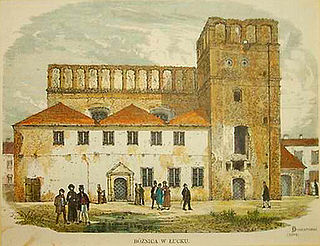
The Great Synagogue is a former Orthodox Jewish synagogue, located at 33 Karaimska Street, in the Jewish quarter of Lutsk, in Volyn Oblast, Ukraine. The congregation worshipped in the Ashkenazi rite.
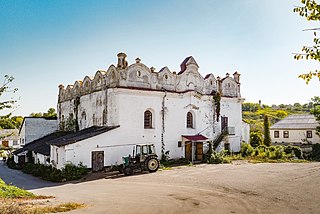
The Great Synagogue is a Jewish synagogue, located in Sharhorod, in the Vinnytsia Oblast of Ukraine. Built in 1589 in what was then the Polish–Lithuanian Commonwealth, it is one of the oldest synagogues in Ukraine.

The Choral Synagogue, also called the Great Synagogue, is an Orthodox Jewish synagogue, located on Pylypa Orlyka Street, in Drohobych, Lviv Oblast in Ukraine. The congregation worships in the Ashkenazi rite.

The Great Synagogue was a former Jewish synagogue, located in Pidhaitsi, Ternopil Oblast in Ukraine. The congregation worshipped in the Ashkenazi rite. Built prior to 1648, the fortress synagogue was abandoned during World War II, was used for grain storage thereafter, then as a ruin before its collapse in 2019 and subsequent demolition.

The Great Synagogue or Choral Synagogue is a former Orthodox Jewish synagogue, located on Yaroslava Mudroho Street, in Bila Tserkva, Kyiv Oblast, Ukraine. The synagogue was built in the former Russian Empire in 1860 and the congregation worshipped in the Ashkenazi rite.
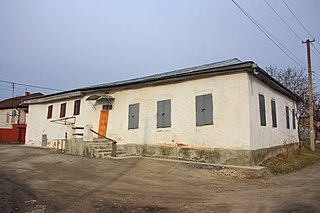
The Bershad Synagogue is an Orthodox Jewish synagogue, located on Narodna Street, in Bershad, in the Vinnytsia Oblast of Ukraine. Built in the beginning of the 19th century, it is one of the very few synagogues in Ukraine that was neither destroyed during World War II nor closed by the Soviet authorities in the years after the war.

The Synagogue of Alanta is a former Jewish congregation and synagogue, located at 3a Ukmergės Street, in Alanta, in the Molėtai District Municipality, in the Utena County of Lithuania. A wooden synagogue that was designed in the Romantic style, the building operated as a synagogue from the mid-19th century until it was devastated by Nazis in 1941. Subsequently used for profane purposes, the building was restored during 2021 and now operates as a cultural center.
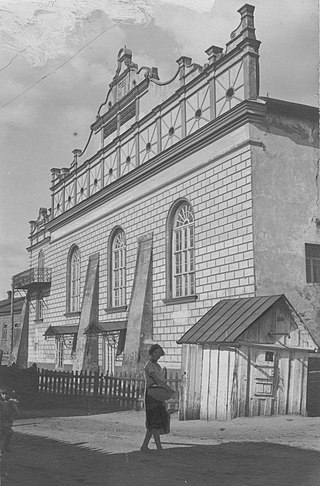
The Great Maharsha Synagogue is a former Jewish synagogue, located in Ostroh, in the Rivne Oblast of Ukraine.




















